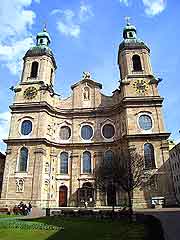Innsbruck History Facts and Timeline
(Innsbruck, Tyrol, Austria)

Archaeological discoveries have shown that Innsbruck has its origins way back in the early part of the Stone Age. History also shows that ever since, this part of Tyrol has been continuously occupied by settlers.
More recently, the 4th century saw the arrival of Roman forces, who chose to base themselves at Veldidena, which is now named 'Wilten' and is a suburb of modern-day Innsbruck. From here, the Romans gained themselves a strategic defensive location, allowing them to protect the important thoroughfare running to
Verona, Trento, Brenner and Augsburg.
Origins of the City
The very first time that Innsbruck is formally mentioned in history documents the Oeni Pontum (Inn Bridge) spanning the River Inn. From 1267 onwards, the city's coat of arms has depicted this bridge and this remains an iconic symbol of the city today.
Passing right through the Alps and running along the Austria /
Italy boundary, the Brenner Pass was a busy road, connecting the north with the south. Innsbruck became something of a transit station, attracting weary travellers and passers-by, and it soon began to prosper due to its fortunate location alongside this popular mountain pass.
A Capital is Born
In the year of 1429, it was announced that Innsbruck would gain the position of capital of Tyrol, western Austria's federal state, and later decades witnessed a period of much growth. The city soon became a hub for European politics and at the end of the 15th century, it was called home by Holy Roman Emperor, Maximilian I.
Innsbruck flourished during this time in history, with the presence of the emperor further adding to its status. The Okarche (Court Church) is a prominent reminder of this era, being built in the middle of the 16th century as a memorial to Maximilian I by his grandson Ferdinand I. Famed for its German Renaissance sculptures, the Hofkirche is also where you will find the tomb of Andreas Hofer (1767 to 1810), a local patriot and Austrian hero who is remembered for his part in the War of the Third Coalition conflict against France (1803 to 1806).
Education, Prosperity and Napoleon
The University of Innsbruck was officially founded in 1699, although soon after it was 'demoted' to a lyceum (school), regaining its university status in 1826, thanks to Emperor Franz I. This is currently Austria's third-biggest university, being today home to over 26,000 students and a staff of roughly 3,000.
Innsbruck enjoyed a period of relative peace and affluence, with many new building projects being successfully completed. However, at the hands of Napoleon Bonaparte, the French Empire had grand plans and Austria was soon in its sights. The Napoleonic Wars (1803 to 1815) saw the state of Tyrol passed to Bavaria, since
Germany was then a trusted ally of
France. It was at this time that Andreas Hofer stepped in and played a key role in the Tyrolean Rebellion, raising an army of peasants and gaining himself a surprising victory at the 1809 Battles of Bergisel.
Bombing in the Second World War
Innsbruck has suffered at the hands of many conflicts over the centuries. However, the damage that it experienced during the Second World War caused nothing short of devastation. Being controlled by Nazi Germany, Austria became a target for Allied bombing and Innsbruck was bombed on no less than 22 separate occasions, between 1943 and 1945. The city was especially targeted due to it being a key railway hub.
A number of the city's oldest landmarks were sadly lost forever, such as the 13th-century Bartholomauskapelle and the 17th-century Servitenkloster monastery. Both the Landhaus (Old Federal State Parliament) and St. James's Cathedral were badly damaged, amongst many other buildings later to be restored.
The History of Innsbruck Today
Visitors to Innsbruck will find that the city still contains many extremely beautiful buildings from yesteryear, with the centre being best explored on foot.
From the Hauptbahnhof (railway station), a short 15-minute walk will see tourists encounter a number of interesting historical attractions, passing by the Maria-Theresien Strasse (Main Street) en route to Old Innsbruck. The Museumstrasse forms the true cultural heart of the city, with its cluster of countless museums, such as the Tiroler Landesmuseum Ferdinandeum.
 Archaeological discoveries have shown that Innsbruck has its origins way back in the early part of the Stone Age. History also shows that ever since, this part of Tyrol has been continuously occupied by settlers.
Archaeological discoveries have shown that Innsbruck has its origins way back in the early part of the Stone Age. History also shows that ever since, this part of Tyrol has been continuously occupied by settlers.